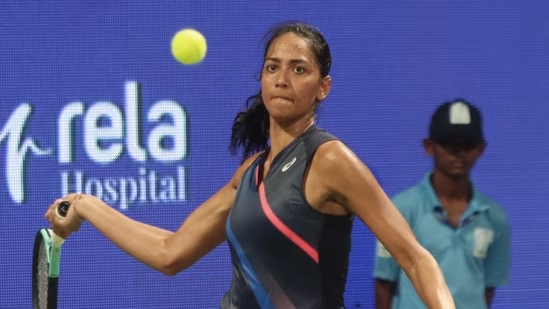Indian tennis: Karman can and she now knows it
Minutes after losing to Eugenie Bouchard in the singles second round of the WTA Chennai Open, Karman Kaur Thandi was back on the court for her doubles Round of 16 with Rutuja Bhosale. The Indian duo rallied from the brink of defeat to win a nearly two-hour contest that ended well past midnight.  PREMIUM
PREMIUM
It’s been a buoyant Chennai Open for Karman for more reasons than one. A late wild card entrant for WTA 250 event, she upset 109th-ranked Chloe Paquet in the first round for her first WTA main draw win since 2018 before losing to the 2014 Wimbledon finalist Eugenie Bouchard in the next round in straight sets from having set points in the second. More importantly for Karman, her body pulled through playing four matches in four days.
For a 24-year-old forced to retire mid-match twice in three tournaments from December 2021 to February 2022, that's perhaps as big a deal as jumping in the rankings to become India’s No 1 woman player in next week’s WTA charts.
As her Chennai display showed and Bouchard acknowledged, her game—those big forehands, specifically—doesn’t do justice to her current ranking of 359. Karman’s frequent injury breakdowns (shoulder, abs, elbow) though have kept her there, regularly pegging her back since she cracked into the top 200 four years ago with the potential and promise for more.
“For me, I know if I focus on my game, do the right things, do the things I’m learning and trust the process, everything else will fall into place, including the rankings,” Karman, who in June also lifted an ITF title after four years, said.
A key chain in that process wheel has been working with Gerald Cordemy, who has been the head of strength and conditioning at the Mouratoglou Tennis Academy. Cordemy came down to RoundGlass Academy in Chandigarh where Karman trains for a few weeks in July, going “through the full process” that they couldn’t when Karman was briefly at the Mouratoglou Academy.
Cordemy, who has worked with the likes of Serena Williams and David Goffin, likened Karman’s body type to that of Juan Martin del Potro, the tall Argentine whose career too was injury-plagued.
“But nobody could say Del Potro was not made for tennis,” Cordemy said. “Karman understood that the best way for her to get rid of her injury issues is to practice at a level where your body gets used to it. Not just sometimes.
“I wanted her to understand that she didn’t have any reason why she got more injured than other players. It was just about knowing them, and then fixing them.”
For those weeks in Chandigarh, Karman would “eat, sleep, play, repeat”. “I had only heard of that before. Now I was doing that,” she smiled. “Every day, I was sweating buckets.”
There was a method to it too. For example, weighing her body every morning before practice and then after it to ascertain how much she needed to hydrate depending on the weight loss.
“The idea was to make it clear in her mind in terms of numbers. Dehydration is one of the major reasons for injuries. So if she lost, say, 1kg, she knew what she had to do,” Cordemy said.
Injuries could creep in from anywhere, Cordemy asserted, but the critical piece in the puzzle was the controllables. “Prevention has to be a priority, followed by recovery,” he said. “Balance, core, intensity—understating how your body works to avoid injuries is key.”
For Karman, those sessions with Cordemy were a “huge learning experience”, not just for the body but also for the mind. “I have never worked like that before,” she said. “I could feel the difference on the physical aspect and how much of a role the mental aspect plays as well—how to deal with situations even when I'm tired, keep those learnings and have them engrained in me.”
The ITF $25,000 Gurugram triumph to end a four-year title wait was a big positive, more so since it came a month after returning to the tour after another injury-enforced break. “That was a good push: that I’m still there. I was able to put my game together, get some good matches under my belt,” she said.
If Karman continues to do that—she has now played nine tournaments since May—she has no reason to believe why her stop-start ride won’t get back on track once again.
“I know for sure things are improving and they will continue to improve,” she said. “For now, it is (about) avoiding injuries. But I will be in a space where I won’t get injured so easily. Working on the body, on the mindset is what will get me there.”
Experience unrestricted digital access with HT Premium
Explore amazing offers on HT + Economist Start 14 Days Free Trial Already Subscribed? Sign In
Disclaimer: The copyright of this article belongs to the original author. Reposting this article is solely for the purpose of information dissemination and does not constitute any investment advice. If there is any infringement, please contact us immediately. We will make corrections or deletions as necessary. Thank you.







